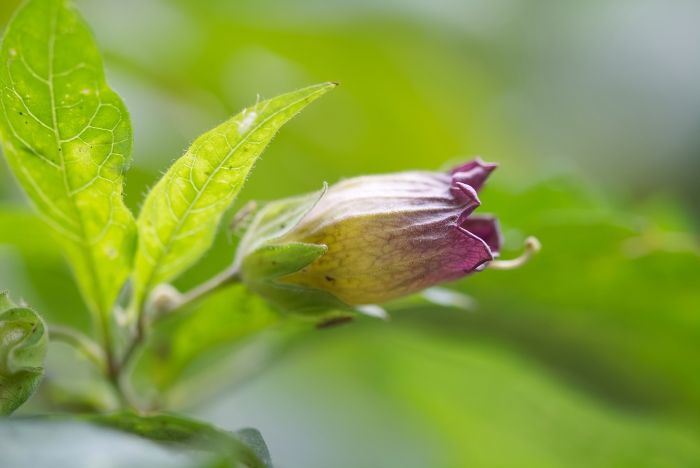Belladonna
(Atropa belladonna)
Belladonna (Atropa belladonna)
/
/

David Sandler
CC BY 4.0
Image By:
David Sandler
Recorded By:
Copyright:
CC BY 4.0
Copyright Notice:
Photo by: David Sandler | License Type: CC BY 4.0 | License URL: http://creativecommons.org/licenses/by/4.0/ | Rights Holder: David Sandler | Publisher: iNaturalist | Date Created: 2021-09-07T16:10:33-07:00 |























Estimated Native Range
Summary
Atropa belladonna, commonly known as belladonna or deadly nightshade, is a toxic perennial herb native to woodland edges, clearings, and coastal scrub in Europe, North Africa, and Western Asia. It thrives in calcareous, nutrient-rich soils but can also be found in disturbed areas. Belladonna grows up to 7 feet tall and has a branching habit. The plant bears dull purple, bell-shaped flowers from June to August, which are followed by shiny black berries. The foliage is dark green, and the overall appearance is both alluring and menacing due to its toxicity.
Belladonna is known for its striking berries and historical significance. While it is not commonly cultivated due to its poisonous nature, it is occasionally grown in witch gardens or for educational purposes in botanical gardens. In cultivation, it requires moist, well-drained soil, partial shade to full sun, and regular watering. It is not typically prone to diseases but can be affected by fungal infections in overly wet conditions. Belladonna contains tropane alkaloids, which are highly toxic and can cause delirium, hallucinations, and even death if ingested. Due to these compounds, it has been used historically as a medicine for its anticholinergic properties, as a cosmetic to dilate pupils, and infamously as a poison.CC BY-SA 4.0
Belladonna is known for its striking berries and historical significance. While it is not commonly cultivated due to its poisonous nature, it is occasionally grown in witch gardens or for educational purposes in botanical gardens. In cultivation, it requires moist, well-drained soil, partial shade to full sun, and regular watering. It is not typically prone to diseases but can be affected by fungal infections in overly wet conditions. Belladonna contains tropane alkaloids, which are highly toxic and can cause delirium, hallucinations, and even death if ingested. Due to these compounds, it has been used historically as a medicine for its anticholinergic properties, as a cosmetic to dilate pupils, and infamously as a poison.CC BY-SA 4.0
Plant Description
- Plant Type: Herb
- Height: 2-6 feet
- Width: 2-3 feet
- Growth Rate: Moderate
- Flower Color: Purple
- Flowering Season: Summer
- Leaf Retention: Deciduous
Growth Requirements
- Sun: Full Sun, Part Shade
- Water: Medium
- Drainage: Medium, Fast
Common Uses
Border Plant, Edible*Disclaimer: Easyscape's listed plant edibility is for informational use. Always verify the safety and proper identification of any plant before consumption.
Natural Habitat
Woodland edges, clearings, and coastal scrub in Europe, North Africa, and Western Asia
Other Names
Common Names: Deadly Nightshade
Scientific Names: , Atropa belladonna, Atropa acuminata, Atropa paschkewiczii, Belladonna baccifera, Belladonna trichotoma,
GBIF Accepted Name: